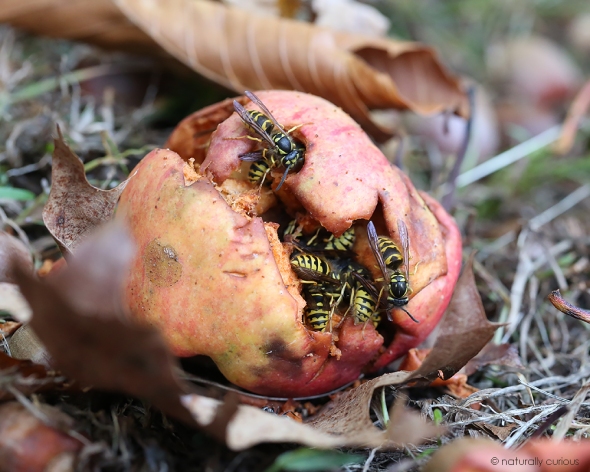Black Bears Raiding Brood
 Previously this fall I posted about Black Bears foraging ferociously in the fall in order to store fat (sometimes doubling their weight) before hibernating. That post showed an ant-infested tree that had been ripped apart. As winter approaches, signs of bears’ frenetic gorging (hyperphagia) increase dramatically. Protein-rich sources such as Bald-faced Hornet nests (suspended from branches) and Yellow Jacket nests (in cavities in the ground) are highly sought after.
Previously this fall I posted about Black Bears foraging ferociously in the fall in order to store fat (sometimes doubling their weight) before hibernating. That post showed an ant-infested tree that had been ripped apart. As winter approaches, signs of bears’ frenetic gorging (hyperphagia) increase dramatically. Protein-rich sources such as Bald-faced Hornet nests (suspended from branches) and Yellow Jacket nests (in cavities in the ground) are highly sought after.
If you look closely, you’ll see that the claws of the bear that attempted to raid the hornet nest (suspended ten feet above the ground) were able to reach just the bottom portion of the nest, tearing the outer multi-layered, paper envelope but not reaching the brood-containing cells within. The Yellow Jacket cells containing brood (eggs, larvae and pupae), on the other hand, were all removed from the ground nest and consumed. All that remains is a portion of the outer envelope and a few adults.
Yellow Jackets On A Bender

At this time of year, yellow jackets, hornets and wasps take advantage of the plethora of fermented fruit that lies underneath fruit trees. Because the queen slows down the production of eggs in the fall, workers have time on their hands, as they have fewer larvae to collect food (chewed-up insects) for. Their life (but not the queen’s) is about to come to an end, and they go out in style. If you have observed these members of the Vespidae family acting more erratic, it may well be because they are drunk on hard cider. (Photo: yellow jackets binging)
Yellow Jackets Rebuilding Nest
 From the size of the chunks of sod that were ripped out of the ground in order to access this subterranean yellow jacket (Vespula sp.) nest, one can deduce that a black bear, not a striped skunk or raccoon, was the nocturnal visitor. Usually there is little intact nest left after a bear tears it apart in an effort to find yellow jacket larvae, but in this case, a portion of the paper nest remained. Apparently undaunted, even with frost in the air (signaling the demise of all the yellow jackets except young, fertilized overwintering queens), the workers lost no time in rebuilding their nest. Twenty-four hours after their nest was torn apart, the colony of yellow jackets had diligently chewed enough wood fiber to have replaced much of it.
From the size of the chunks of sod that were ripped out of the ground in order to access this subterranean yellow jacket (Vespula sp.) nest, one can deduce that a black bear, not a striped skunk or raccoon, was the nocturnal visitor. Usually there is little intact nest left after a bear tears it apart in an effort to find yellow jacket larvae, but in this case, a portion of the paper nest remained. Apparently undaunted, even with frost in the air (signaling the demise of all the yellow jackets except young, fertilized overwintering queens), the workers lost no time in rebuilding their nest. Twenty-four hours after their nest was torn apart, the colony of yellow jackets had diligently chewed enough wood fiber to have replaced much of it.
Naturally Curious is supported by donations. If you choose to contribute, you may go to http://www.naturallycuriouswithmaryholland.wordpress.com and click on the yellow “donate” button.


















What Other Naturally Curious People Are Saying